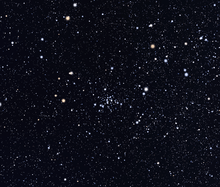NGC 4103
NGC 4103 is an open cluster in the constellation Crux. It was discovered by James Dunlop in 1826. It is located approximately 5,000 light years away from Earth, in the Carina-Sagittarius arm.[5]
| NGC 4103 | |
|---|---|
 | |
| Observation data (J2000 epoch) | |
| Constellation | Crux |
| Right ascension | 12h 00m 39s[1] |
| Declination | −61° 55′ 00″[1] |
| Distance | 5,320 ly (1,632 pc[2]) |
| Apparent magnitude (V) | 7.4 [1] |
| Apparent dimensions (V) | 12'[3] |
| Physical characteristics | |
| Mass | 1,180[4] M☉ |
| Estimated age | 25 million years[2] |
| Other designations | Collinder 252, Melotte 109 |
Characteristics

NGC 4103 is a young open cluster. Its age has been determined to be 30 Myr by Sagar & Cannon (1997),[6] 20 ± 5 Myr by Sanner et al. (2001)[7] and 6 Myr by Piskunov et al. (2004).[8] The metallicity of NGC 4103 is subsolar (−0.47).[9] The tidal radius of the cluster is 12.1 - 15.9 parsecs (39 - 51 light years) and represents the average outer limit of NGC 4103, beyond which a star is unlikely to remain gravitationally bound to the cluster core.[4]
Members
There are 421 probable member stars within the angular radius of the cluster and 199 within the central part of the cluster.[3] No blue straggler has been detected in the cluster.[10] The cluster is not very richly populated and is dominated by moderately bright stars of 10th magnitude and fainter.[7] The hottest stars of the cluster are of spectral type B2.[11] No red giants have been found to be members of the cluster.[7] One member of the cluster is a Be star.[7][12]
Among the members of the cluster is AI Crucis, a short-period semi-detached massive close binary star, with orbit period 1.41771 days. The orbital period of the binary is continuously increasing and this has been explained on the grounds of mass transfer from the less massive component to the more massive one and strong stellar wind from the hot component. It is estimated that 4.1 M☉ have been transferred from the hot component to the more massive.[13]
References
- "NGC 4103". SIMBAD. Centre de données astronomiques de Strasbourg. Retrieved 2017-08-19.
- WEBDA page for open cluster NGC 4103
- Kharchenko, N. V.; Piskunov, A. E.; Schilbach, E.; Röser, S.; Scholz, R.-D. (3 October 2013). "Global survey of star clusters in the Milky Way". Astronomy & Astrophysics. 558: A53. arXiv:1308.5822. Bibcode:2013A&A...558A..53K. doi:10.1051/0004-6361/201322302.
- Piskunov, A. E.; Schilbach, E.; Kharchenko, N. V.; Röser, S.; Scholz, R.-D. (6 November 2007). "Tidal radii and masses of open clusters". Astronomy & Astrophysics. 477 (1): 165–172. Bibcode:2008A&A...477..165P. doi:10.1051/0004-6361:20078525.
- Carraro, Giovanni; Turner, David G.; Majaess, Daniel J.; Baume, Gustavo L.; Gamen, Roberto; Lera, José A. Molina (13 March 2017). "Extinction in the Star Cluster SAI 113 and Galactic Structure in Carina". The Astronomical Journal. 153 (4): 156. arXiv:1701.08319. Bibcode:2017AJ....153..156C. doi:10.3847/1538-3881/aa5c3a.
- Sagar, R.; Cannon, R. D. (15 April 1997). "Multicolour deep CCD photometric study of the moderately youngsouthern open star clusters NGC 3228, NGC 4103, NGC 5662 and NGC 6087". Astronomy and Astrophysics Supplement Series. 122 (1): 9–29. Bibcode:1997A&AS..122....9S. doi:10.1051/aas:1997293.
- Sanner, J.; Brunzendorf, J.; Will, J.-M.; Geffert, M. (15 April 2001). "Photometric and kinematic studies of open star clusters". Astronomy & Astrophysics. 369 (2): 511–526. arXiv:astro-ph/0101541. Bibcode:2001A&A...369..511S. doi:10.1051/0004-6361:20010196.
- Piskunov, A. E.; Belikov, A. N.; Kharchenko, N. V.; Sagar, R.; Subramaniam, A. (April 2004). "On the determination of age and mass functions of stars in young open star clusters from the analysis of their luminosity functions". Monthly Notices of the Royal Astronomical Society. 349 (4): 1449–1463. arXiv:astro-ph/0401587. Bibcode:2004MNRAS.349.1449P. doi:10.1111/j.1365-2966.2004.07620.x.
- Paunzen, E.; Heiter, U.; Netopil, M.; Soubiran, C. (28 July 2010). "On the metallicity of open clusters". Astronomy and Astrophysics. 517: A32. arXiv:1008.3476. Bibcode:2010A&A...517A..32P. doi:10.1051/0004-6361/201014131.
- Ahumada, J. A.; Lapasset, E. (20 November 2006). "New catalogue of blue stragglers in open clusters". Astronomy & Astrophysics. 463 (2): 789–797. Bibcode:2007A&A...463..789A. doi:10.1051/0004-6361:20054590.
- Wesselink, A. J. (1 October 1969). "Photometry of NGC 4103". Monthly Notices of the Royal Astronomical Society. 146 (3): 329–338. Bibcode:1969MNRAS.146..329W. doi:10.1093/mnras/146.3.329.
- Paunzen, E.; Netopil, M.; Maitzen, H. M.; Pavlovski, K.; Schnell, A.; Zejda, M. (3 April 2014). "Photoelectric search for peculiar stars in open clusters". Astronomy & Astrophysics. 564: A42. arXiv:1403.3538. Bibcode:2014A&A...564A..42P. doi:10.1051/0004-6361/201423521.
- Zhao, Er-Gang; Qian, Sheng-Bang; Lajús, E. Fernández; Essen, Carolina von; Zhu, Li-Ying (May 2010). "Mass transfer and loss of the massive semi-detached binary AI Crucis". Research in Astronomy and Astrophysics. 10 (5): 438–444. Bibcode:2010RAA....10..438Z. doi:10.1088/1674-4527/10/5/004.
External links
| Wikimedia Commons has media related to NGC 4103. |
- NGC 4103 on WikiSky: DSS2, SDSS, GALEX, IRAS, Hydrogen α, X-Ray, Astrophoto, Sky Map, Articles and images